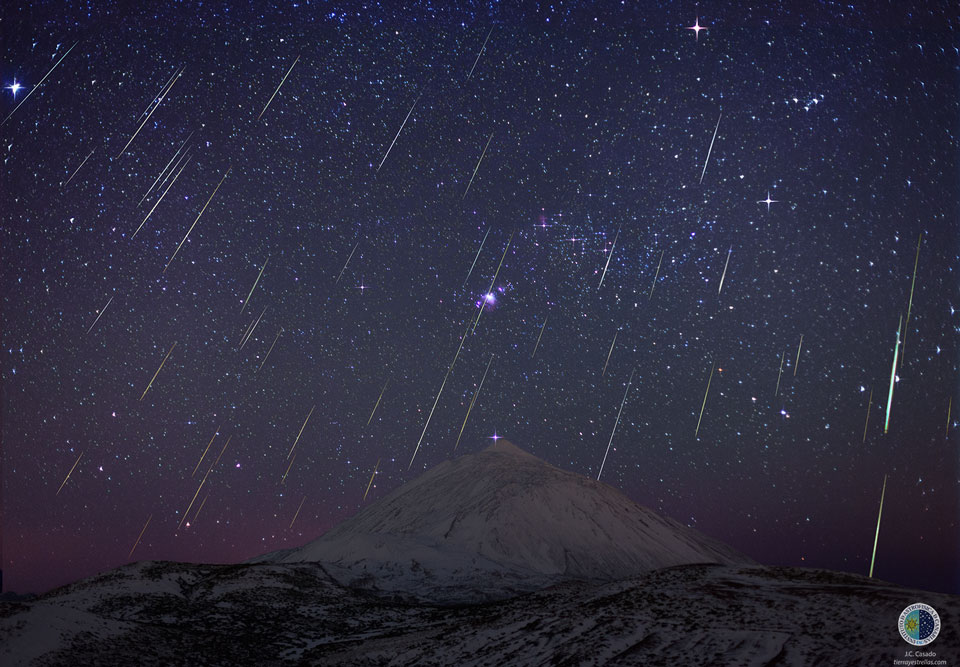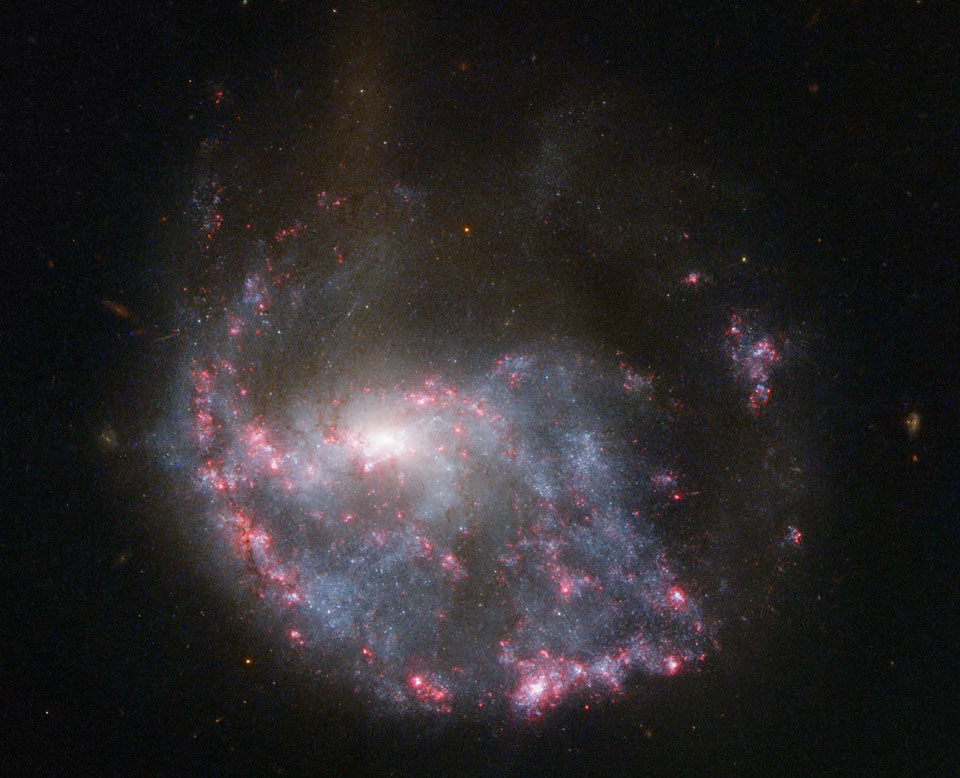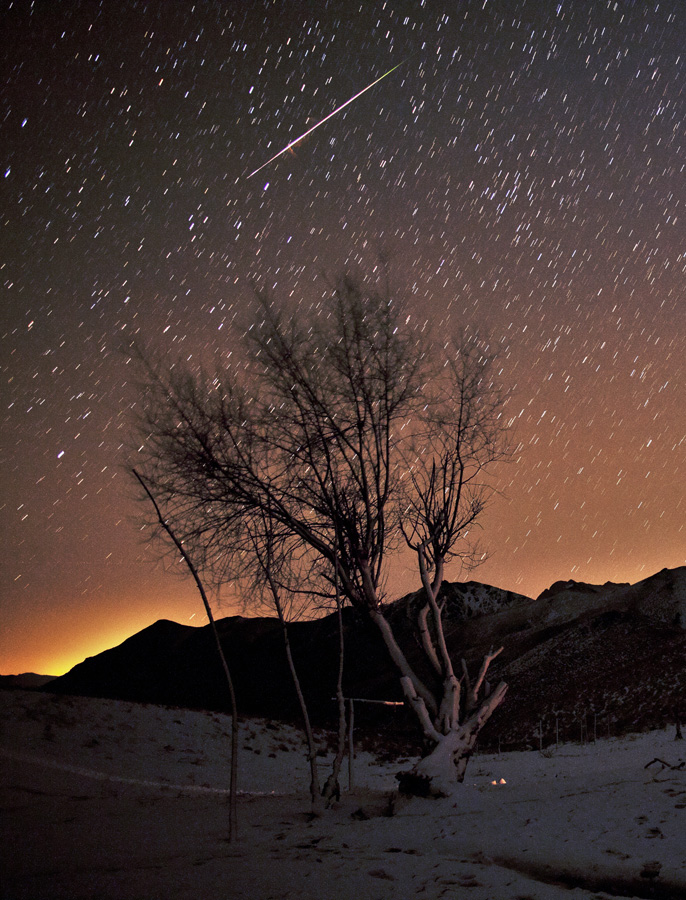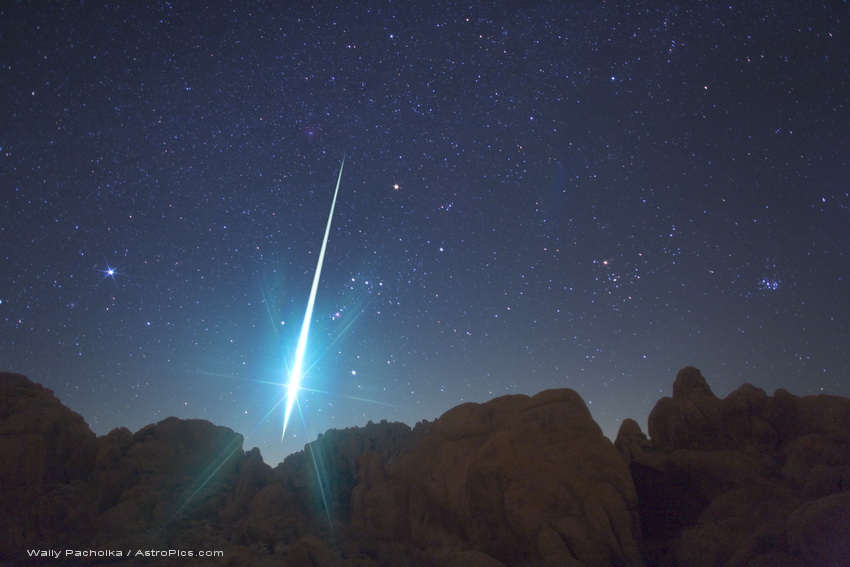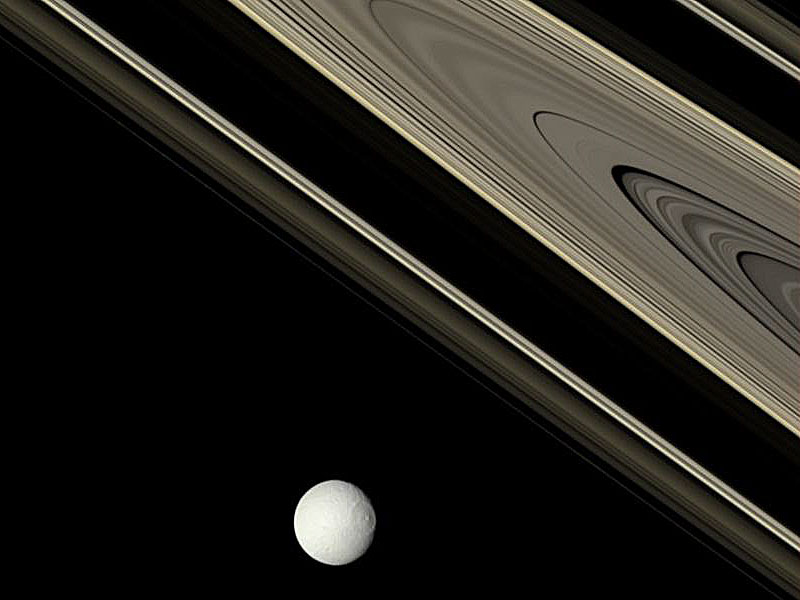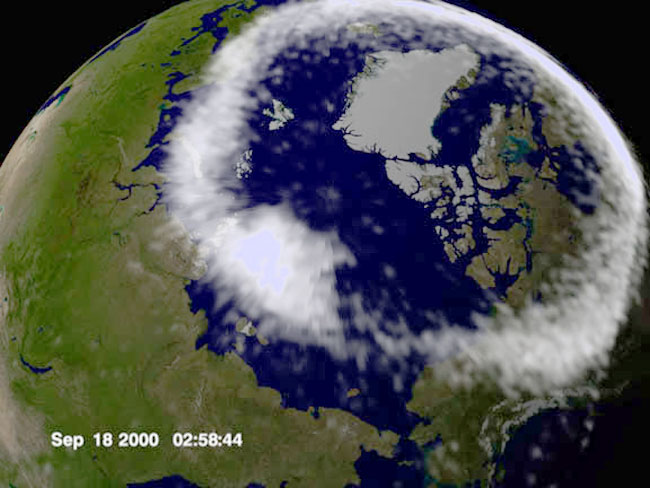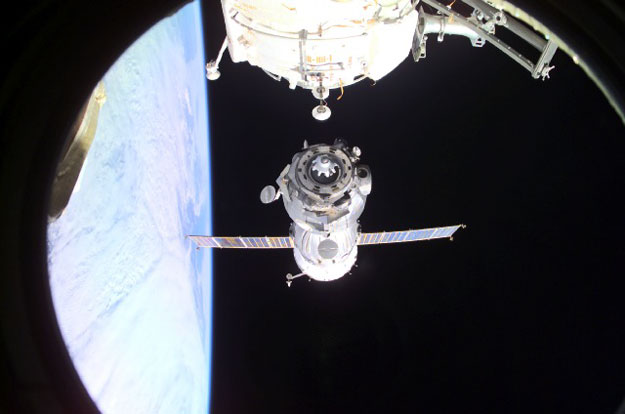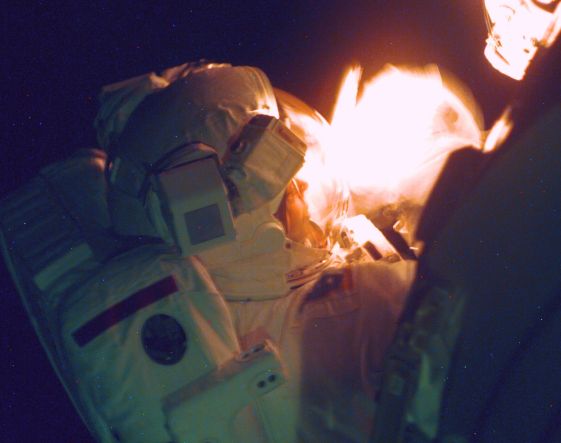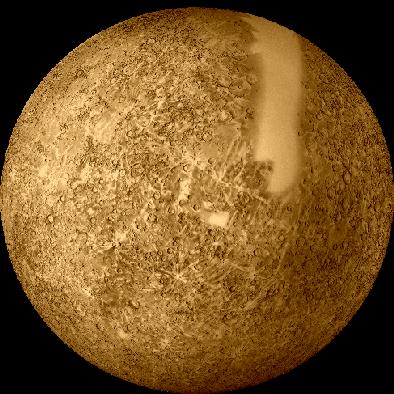| << Previous | Index | Next >> |
2014 This was a sky to remember. While viewing the Geminids meteor shower a few days ago, a bright fireball was captured over Mt. Balang, China with particularly picturesque surroundings. In the foreground, a sea of light clouds slowly floated between dark mountain peaks. In the background, the constellation of Orion shone brightly, with the familiar three stars of Orion's belt visible near the image top right. Sirius, the brightest star in the night sky, is visible near the image center. The bright fireball flashed for only a fraction of second on the lower right. The source of the fireball was a pebble that intersected the protective atmosphere of Earth, originally expelled by the Sun-orbiting asteroid-like object 3200 Phaethon.
2013 On some nights it rains meteors. Peaking two nights ago, asteroid dust streaked through the dark skies of Earth, showering down during the annual Geminids meteor shower. Astrophotographer Juan Carlos Casado captured the space weather event, as pictured above, in a series of exposures spanning about 2.3 hours using a wide angle lens. The snowcapped Teide volcano of the Canary Islands of Spain towers in the foreground, while the picturesque constellation of Orion highlights the background. The star appearing just near the top of the volcano is Rigel. Although the asteroid dust particles are traveling parallel to each other, the resulting meteor streaks appear to radiate from a single point on the sky, in this case in the constellation of Gemini, off the top of the image. Like train tracks appearing to converge in the distance, the meteor radiant effect is due to perspective. The astrophotographer has estimated that there are about 50 Geminids visible in the above composite image -- how many do you see?
2012 Why does this galaxy have so many big black holes? No one is sure. What is sure is that NGC 922 is a ring galaxy created by the collision of a large and small galaxy about 300 million years ago. Like a rock thrown into a pond, the ancient collision sent ripples of high density gas out from the impact point near the center that partly condensed into stars. Pictured above is NGC 922 with its beautifully complex ring along the left side, as imaged recently by the Hubble Space Telescope. Observations of NGC 922 with the Chandra X-ray Observatory, however, show several glowing X-ray knots that are likely large black holes. The high number of massive black holes was somewhat surprising as the gas composition in NGC 922 -- rich in heavy elements -- should have discouraged almost anything so massive from forming. Research is sure to continue. NGC 922 spans about 75,000 light years, lies about 150 million light years away, and can be seen with a small telescope toward the constellation of the furnace (Fornax).
2011 Like most other sungrazing comets, Comet Lovejoy (C/2011 W3) was not expected to survive its close encounter with the Sun. But it did. This image from a coronograph onboard the sun-staring SOHO spacecraft identifies the still inbound remnants of the tail, with the brilliant head or coma emerging from the solar glare on December 16. The Sun's position, behind an occulting disk to block the overwhelming glare, is indicated by the white circle. Separated from its tail, Comet Lovejoy's coma is so bright it saturates the camera's pixels creating the horizontal streaks. Based on their orbits, sungrazer comets are thought to belong to the Kreutz family of comets, created by successive break ups from a single large parent comet that passed very near the Sun in the twelfth century. Most have been discovered with SOHO's cameras, but unlike many sungrazers, this one was first spotted by Australian astronomer Terry Lovejoy from an earth-based observatory. Comet Lovejoy is estimated to have come within 120,000 kilometers of the Sun's surface and likely had a large cometary nucleus to have survived its intense perihelion passage. Remarkable videos of the encounter from the Solar Dynamics Observatory can be found here.
2010 Intensely bright, this fireball meteor flashed through Tuesday's cold, clear, early morning skies over the Karkas Mountains in central Iran, near the peak of the annual Geminid Meteor Shower. To capture the meteor moment and wintery night skyscape, the photographer's camera was fixed to a tripod, its shutter open for about 1.5 minutes. During that time, the multitude of stars slowly traced short, arcing trails through the sky, a reflection of planet Earth's daily rotation on its axis. The meteor's brilliant dash through the scene was brief, though. Changing color as it went, it also left a reddish swirl of hot, glowing gas near the center of its path. The mountains appear in silhouette against the steady glow of distant city lights.
2009 Monstrously bright, this fireball meteor lit up the Mojave Desert sky Monday morning, part of this year's impressive Geminid meteor shower. Seen toward the southwest over rock formations near Victorville, California, a more familiar celestial background was momentarily washed out by the meteor's flash. The background includes bright star Sirius at the left, and Aldebaran and the Pleaides star cluster at the right side of the image. The meteor itself blazes through the constellation Orion. Its greenish trail begins just left of a yellow-tinted Betelgeuse and points back to the shower's radiant in Gemini, just off the top of the frame. A rewarding catch for photographer Wally Pacholka, the spectacular image is one of over 1500 frames that he reports captured 48, mostly faint, Geminid meteors.
2008 These two nebulae are cataloged as M27 (left) and M76, popularly known as The Dumbbell and the Little Dumbbell. Not intended to indicate substandard mental prowess, their popular names refer to their similar, dumbbell or hourglass shapes. Both are planetary nebulae, gaseous shrouds cast off by dying sunlike stars, and are similar in physical size, at a light-year or so across. In each panel, the images were made at the same scale, so the apparent size difference is mostly because one is closer. Distance estimates suggest 1,200 light-years for the Dumbbell compared to 3,000 light-years or more for the Little Dumbell. These deep, narrow-band, false-color images show some remarkably complex structures in M27 and M76, highlighting emission from hydrogen, nitrogen, and oxygen atoms within the cosmic clouds.
2007 How old are Saturn's rings? No one is quite sure. One possibility is that the rings formed relatively recently in our Solar System's history, perhaps only about 100 million years ago when a moon-sized object broke up near Saturn. Evidence for a young ring age includes a basic stability analysis for rings, and the fact that the rings are so bright and relatively unaffected by numerous small dark meteor impacts. New evidence, however, raises the possibility that some of Saturn's rings may be billions of years old and so almost as old as Saturn itself. Inspection of images by the Saturn-orbiting Cassini spacecraft indicates that some of Saturn's ring particles temporarily bunch and collide, effectively recycling ring particles by bringing fresh bright ices to the surface. Seen here, Saturn's rings were imaged in their true colors by the robotic Cassini in late October. Icy bright Tethys, a moon of Saturn likely brightened by a sandblasting rain of ice from sister moon Enceladus, is visible in front of the darker rings.
2006 This tiny ball provides evidence that the universe will expand forever. Measuring slightly over one tenth of a millimeter, the ball moves toward a smooth plate in response to energy fluctuations in the vacuum of empty space. The attraction is known as the Casimir Effect, named for its discoverer, who, 50 years ago, was trying to understand why fluids like mayonnaise move so slowly. Today, evidence is accumulating that most of the energy density in the universe is in an unknown form dubbed dark energy. The form and genesis of dark energy is almost completely unknown, but postulated as related to vacuum fluctuations similar to the Casimir Effect but generated somehow by space itself. This vast and mysterious dark energy appears to gravitationally repel all matter and hence will likely cause the universe to expand forever. Understanding vacuum fluctuations is on the forefront of research not only to better understand our universe but also for stopping micro-mechanical machine parts from sticking together.
2005 In December of 1972, Apollo 17 astronauts Eugene Cernan and Harrison Schmitt spent about 75 hours on the Moon, in the Taurus-Littrow valley, while colleague Ronald Evans orbited overhead. Near the beginning of their third and final excursion across the lunar surface, Schmitt took this picture of Cernan flanked by an American flag and their lunar rover's umbrella-shaped high-gain antenna. The prominent Sculptured Hills lie in the background while Schmitt's reflection can just be made out in Cernan's helmet. The Apollo 17 crew returned with 110 kilograms of rock and soil samples, more than from any of the other lunar landing sites. Cernan and Schmitt are still the last to walk on the Moon.
2004 In Greek Mythology, Prometheus was known for stealing fire from the gods. Ironically, in a story for more modern times Prometheus may also become known for stealing, but this time for stealing icy particles from Saturn's rings. This eerie close-up from the Cassini spacecraft shows the 100 kilometer-long Saturnian moon Prometheus orbiting near the inner edge of Saturn's F ring. The dramatic view clearly resolves the potato-shaped moon and multiple strands of the narrow F ring. It also reveals a faint strand of material connecting Prometheus with the rings. One possibility is that the tiny moon's gravity is indeed drawing off particles from the rings and is influencing the formation of the gaps and kinks seen in the ring structure.
2003 What are auroras made out of? Triggered by solar activity, normal auroras are caused by collisions between fast-moving electrons and the oxygen and nitrogen in Earth's upper atmosphere. The electrons come from the magnetosphere, the region of space controlled by Earth's magnetic field. As the excited oxygen and nitrogen molecules return to their low energy state, they emit light, seen as the auroral glow. Sometimes, however, auroras can be caused by collisions with heavier protons, causing a more energetic display with strong ultraviolet emission. In addition, protons can temporarily capture an electron and emit light for themselves. Such a proton aurora is seen above, recorded by the IMAGE satellite. A special feature is the bright spot near picture center, embedded in a ring of auroral emission around the north magnetic pole of planet Earth. Most solar wind protons never reach the Earth to cause auroras because they are completely deflected away at a great distance by the Earth's magnetic field. The bright spot in the auroral ring indicates a particularly deep crack in the Earth's magnetic field where protons were able to flow along a temporarily connected region between the Sun and the Earth, relatively undeflected, until they impacted the Earth's ionosphere.
2002 The International Space Station (ISS) will be the largest human-made object ever to orbit the Earth. The station is so large that it could not be launched all at once -- it is being built piecemeal with large sections added continually by flights of the Space Shuttle. To function, the ISS needs trusses to keep it rigid and to route electricity and liquid coolants. These trusses are huge, extending over 15 meters long, and with masses over 10,000 kilograms. Pictured above at the end of last month, astronaut Michael Lopez-Alegria works to install the Port-One Truss. On the right is the end of Canadarm2, the robotic remote control arm of the ISS.
2001 It was time to go home. During their eight days aboard the Earth-orbiting International Space Station (ISS), ESA Flight Engineer Claudie Haigner, Russian Commander Victor Afanasyev, and Russian Flight Engineer Konstantin Kozeev had completed several experiments and successfully delivered a new lifeboat. The lifeboat was actually the new Soyuz capsule they arrived in -- they returned home in an older Soyuz capsule that had been left six months ago. Haigner, an expert in rheumatology and neuroscience, studied the development of frog embryos under microgravity conditions. Pictured above on October 31, their Soyuz spacecraft undocks from the ISS while dark space and a blue Earth hover in the background.
2000 Are stars better appreciated for their art after they die? Actually, stars usually create their most artistic displays as they die. In the case of low-mass stars like our Sun and M2-9 pictured above, the stars transform themselves from normal stars to white dwarfs by casting off their outer gaseous envelopes. The expended gas frequently forms an impressive display called a planetary nebula that fades gradually over thousand of years. M2-9, a butterfly planetary nebula 2100 light-years away shown in representative colors, has wings that tell a strange but incomplete tale. In the center, two stars orbit inside a gaseous disk 10 times the orbit of Pluto. The expelled envelope of the dying star breaks out from the disk creating the bipolar appearance. Much remains unknown about the physical processes that cause planetary nebulae.
1999 The Hydra A galaxy cluster is really big. In fact, such clusters of galaxies are the largest gravitationally bound objects in the Universe. But individual galaxies are too cool to be recorded in this false-color Chandra Observatory X-ray image which shows only the 40 million degree gas that permeates the Hydra A cluster. Astronomers have discovered that such X-ray hot gas clouds, millions of light-years across, are common in galaxy clusters. They expected the gas to be cooling and smoothly flowing into the clusters' central regions to form new galaxies and stars. Instead, the Chandra image shows details around the X-ray bright cluster core which suggest that magnetic fields and explosive events disturb the flow, deflecting the gas into loops and long structures and possibly inhibiting the formation of more cluster galaxies and stars.
1998 For the orbiting International Space Station (ISS), the sun sets every 90 minutes. But working through the night, spacewalking astronauts can rely on artificial lighting. Here, the eerie glow of work-lights illuminate Space Shuttle Endeavor astronaut Jerry Ross during a night on his second spacewalk as he continues the in orbit assembly of the ISS. Endeavor landed at Kennedy Space Center Tuesday night bringing an end to the successful ISS assembly mission and the final shuttle mission of 1998.
1997 Stonehenge consists of large carved stones assembled about 4000 years ago. Long before modern England was established, ancient inhabitants somehow moved 25 ton rocks nearly 20 miles to complete it. From similar constructs of the era, people could learn the time of year by watching how the Sun and Moon rose and set relative to accurately placed stones and pits. The placement of the boulders at Stonehenge, however, is not impressively accurate by today's standards, nor even by the standards of that time. Therefore, modern scholars interpret Stonehenge as a colossal monument to the Sun in celebration of the predictability of the seasons.
1996 Mercury, the closest planet to the Sun, remains the most mysterious of the Solar System's inner planets. Hiding in the Sun's glare it is a difficult target for Earth bound observers. The only spacecraft to explore Mercury close-up was Mariner 10 which executed 3 flybys of Mercury in 1974 and 1975, surveying approximately 45 percent of its surface. Mariner 10 deftly manuevered to photograph part of the sunlit hemisphere during each approach, passed behind the planet, and continued to image the sun-facing side as the spacecraft receded. Its highest resolution photographs recorded features approximately a mile across. A recent reprocessing of the Mariner 10 data has resulted in this dramatic mosaic. Like the Earth's Moon, Mercury's surface shows the scars of impact cratering - the smooth vertical band and patches visible above represent regions where no image information is available.
1995 Hundreds of kilometers above the Earth's surface, the United States Space Shuttle Atlantis docks with the Russian Space Station Mir. The photograph was taken by Nikolai Budarin from a Russian Soyuz spacecraft on July 4, 1995. During this mission astronauts answered questions from school students over amateur radio, and performed life science experiments aboard the SpaceLab. The SpaceLab experiments were designed to understand how the Russian Space program combats the effects on the human body of the long-durations in space.
| << Previous | Index | Next >> |

